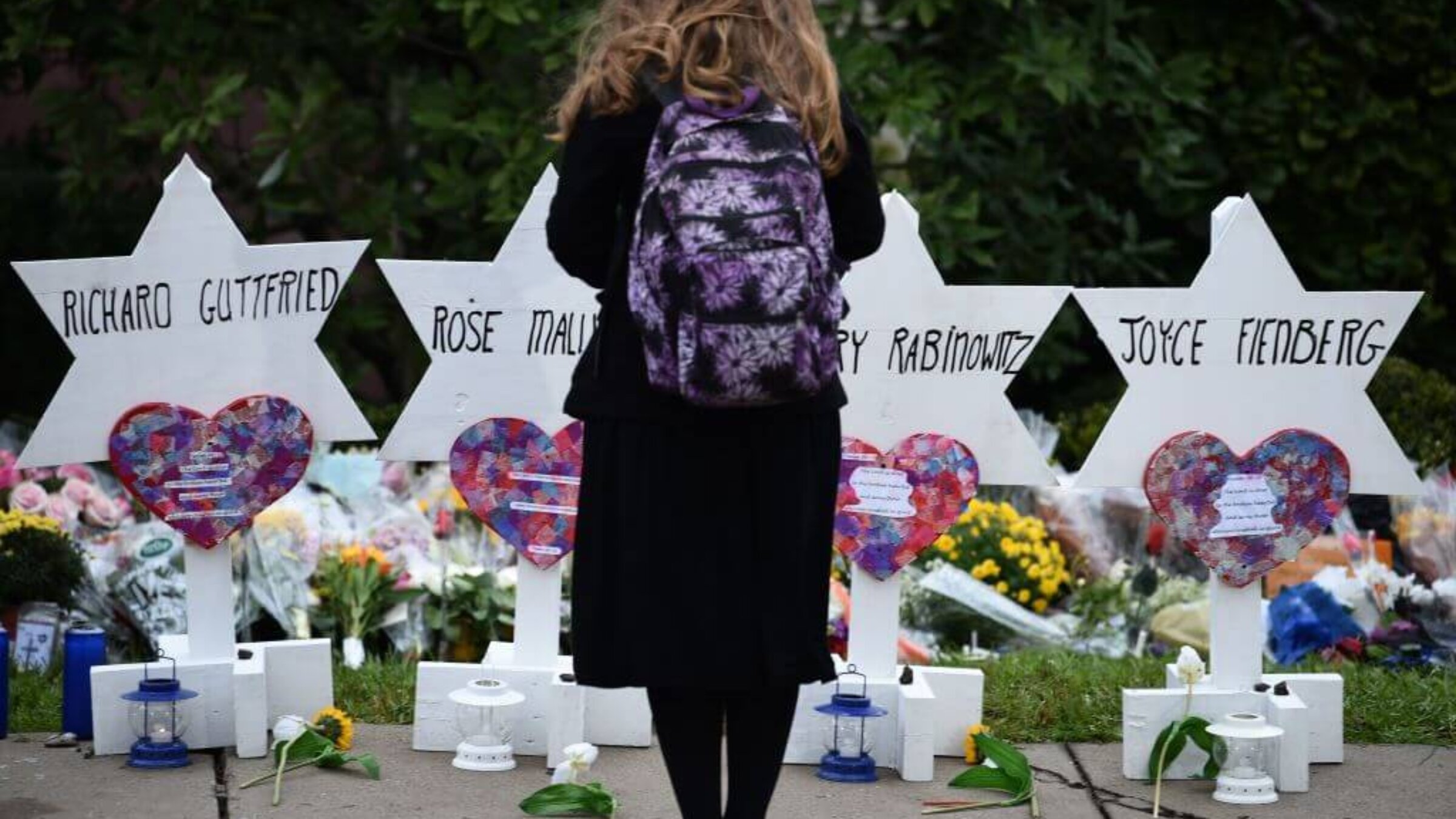As a Jewish Squirrel Hill native, how should I honor the tragedy of Tree of Life?
I can tell my children about that day, but I still struggle to contextualize the hate that befell my hometown

A child stands at a memorial outside the Tree of Life synagogue after a shooting there left 11 people dead in the Squirrel Hill neighborhood of Pittsburgh. Photo by Brendan Smialowski/AFP via Getty Images
Oct. 27, 2018, marks the deadliest antisemitic attack in the history of the United States. Shortly after services began at the Tree of Life congregations in Pittsburgh’s Squirrel Hill neighborhood, a man entered the sanctuary and murdered 11 worshippers.
The Tree of Life shooting brought an end to the centuries of American Jewish life without a mass murder of Jews. As a Squirrel Hill native, I have struggled to figure out what it means to live with this reality.
The memory of that Saturday haunts me every time Shabbat ends and I turn on my phone after Havdalah, hoping that nothing catastrophic has occurred. It sits with me when I drop my children off at their Jewish day school, with a prayer that everyone will remain safe. I feel dread in the pit in my stomach when I pass by the guard at the entrance to our synagogue. It’s deeply unsettling, like a foul odor lingering in my home that I cannot seem to identify or flush out.
I imagine my children will have many questions for me as they grow up. Most of these questions will be about the happenings of everyday life — I will have to explain poor fashion choices, odd food combinations and strange behaviors that will seem backward and silly, as the world continues to progress.
But some questions will force me to step beyond and take on the role of witness, to personally testify to significant moments in American Jewish history. “Tell us about Tree of Life,” they’ll certainly request.
Certainly, I can recall the events as they happened. I can explain where I was, what I did, and how I coped. But I will not be able to satisfy their need to understand and contextualize the underlying hate. How can I make this personal and meaningful to future generations? Some days I simply want to avoid it entirely.
Though I have been an observant Jew my entire life, I’ve never felt comfortable engaging with tragic Jewish history. When I was a teenager, several of my friends visited Europe in organized tourist groups to see shtetls, ghettos and concentration camps — places where Jewish life was extinguished, and then memorialized.
I was fearful, unsure of my own emotional capacity to grapple with all of this and uncomfortable with the exoticism these tours seemed to promote. To me, Jewish life was not foreign and mystical — it was taking place right before my eyes: in the aisles of our local store, Murray Avenue Kosher; in the synagogues and schools; at the Jewish Community Center where stars and flags adorn so many walls.

I did not need to see or experience a history of tattered pages, dilapidated buildings and preserved monuments in order to feel connected to a complex tapestry that ties Judaism together.
As a Squirrel Hill native, I feel compelled to engage with the historical record of this tragic event, but I lack the tools. Where do I begin? And where do I end?
Perhaps the answer is to start from the present rather than the past, by thinking of history as an extension of the moments we live today. We can start by looking back a day ago, then a week ago and a month ago, to slowly but surely trace our everyday experiences to those monumental moments that have shaped them. And then, when we hit a wall, we can push even further.
There is a history that surrounds the Tree of Life massacre. It includes the history of Jewish people in Pittsburgh, of Jews in industrial American cities, of Jews who have maintained their communal ties and religious institutions while grappling with various forms of assimilation. And it includes a history of harassment and persecution of Jews in tandem with forms of oppression against other minority groups.
It’s been four years since that terrible day. But it’s also been five days since I last attended a synagogue, where I was greeted by a security officer. It’s been six weeks since I drove past Tree of Life congregations while visiting my parents, several months since I last discussed guns in shuls as a security measure, and how prepared people are to use them.
Each of these moments ties me back — both to that fateful day, and to the long arc of Jewish history. Perhaps it is in these small moments of living that one can memorialize the souls we’ve lost, may Hashem avenge their blood.
To contact the author, email [email protected].

















